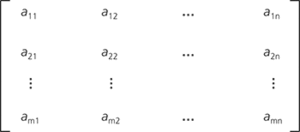An ordered collection of elements, usually numbers. A vector is an example of a 1-dimensional array, and a matrix is an example of a 2-dimensional array. Three or more dimensional arrays are more difficult to represent on paper, though the subscript notation aij = the element in the i-th row and j-th column of a matrix easily generalizes to higher dimensions. Arrays are equal if all corresponding elements are equal. Compare tensor.
1. A group of telescopes or antennas (elements) arranged to operate as a single instrument. See also Interferometer; Phased Array.
2. A regular arrangement of detectors such as CCDs or infrared detectors placed in the focal plane of a telescope, either in a line (a one-dimensional array) or in a plane (a two-dimensional array), and designed to record an image of a source.
1. An ordered collection of elements of the same type, the number of elements being fixed unless the array is flexible.
Each element in an array is distinguished by a unique list of index values that determine its position in the array. Each index is of a discrete type. The number of indices is fixed, and the number and ordering of the indices determines the dimensionality of the array.
A one-dimensional array, or vector, consists of a list of elements distinguished by a single index. If v is a one-dimensional array and i is an index value, then vi refers to the ith element of v. If the index ranges from L through U then the value L is called the lower bound of v and U is the upper bound. Usually in mathematics and often in mathematical computing the index type is taken as integer and the lower bound is taken as one.
In a two-dimensional array, or matrix, the elements are ordered in the form of a table comprising a fixed number of rows and a fixed number of columns. Each element in such an array is distinguished by a pair of indexes. The first index gives the row and the second gives the column of the array in which the element is located. The element in the ith row and jth column is called the i,jth element of the array. If i ranges from L1 through U1 and j ranges from L2 through U2 then L1 is the first lower bound of the array, U1 is the first upper bound, L2 is the second lower bound and U2 is the second upper bound. Again it is common practice to take the indexes as integers and to set both L1 and L2 equal to one. An example of such a two-dimensional array with U1 = m, U2 = n is given in the diagram.
In three-dimensional arrays the position of each element is distinguished by three indexes. Arrays of higher dimension are similarly defined.
2. Short for disk array. See also RAID.

Array. Two-dimensional array
A geometrical distribution or pattern. A line of geophones or shot points constitutes an array, as does a line of electrodes for a resistivity survey. See also electrode configuration.
- warble
- Warburg, Otto Heinrich
- warchalking
- war crimes
- warcycling
- war dialler
- Ward, James (1843–1925)
- Ward, Joe Henry Jnr (1926–2011)
- wardriving
- Wardrobe
- Ward, Sir Joseph George (1856–1930)
- Ward's method
- Ward–Mellor
- ware display
- Warendian
- Warepan
- warez
- warfarin
- Waring’s problem
- war, just
- warlords
- warm-blooded animal
- warm boot
- warm front
- warm glacier